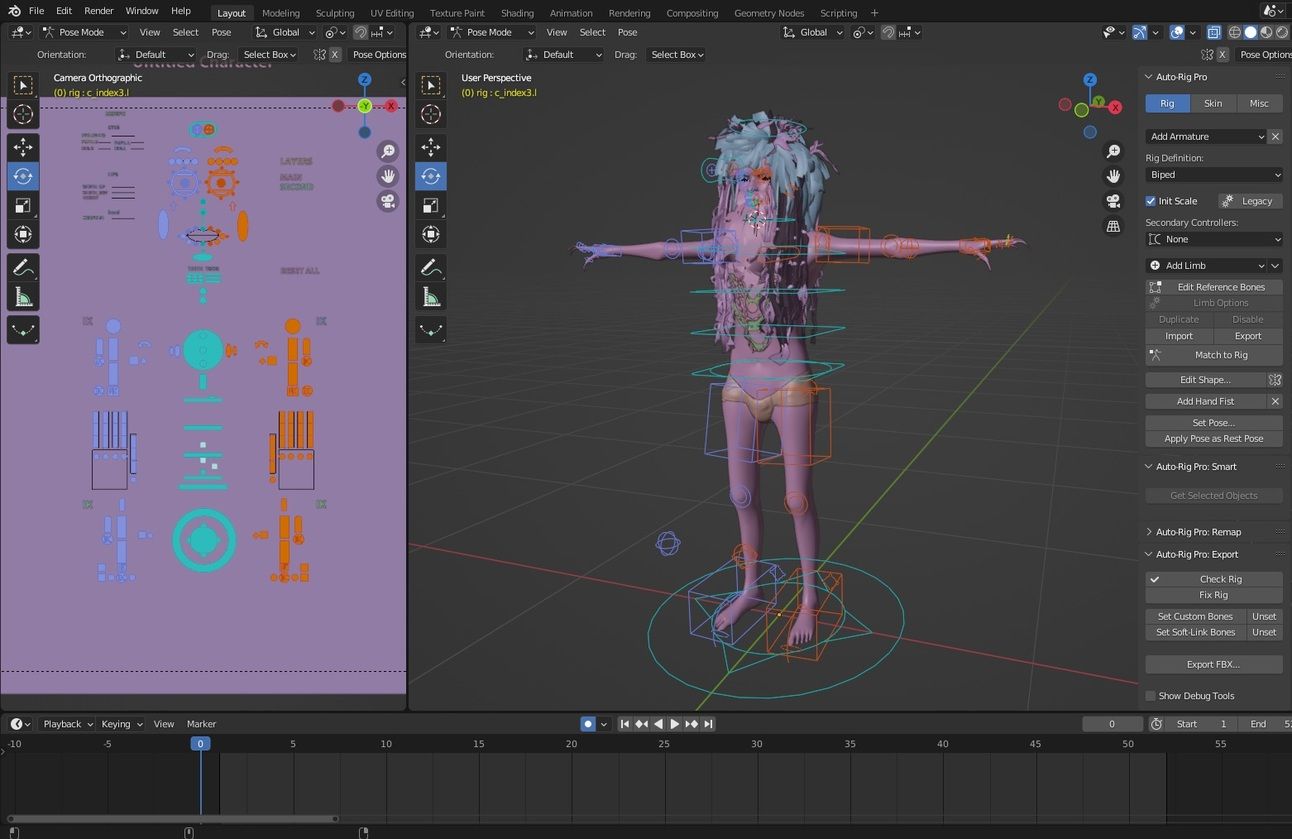- BornMonkie Blog
- Posts
- Inside BornMonkie: The Tools and Tech Powering Indie Game Development!
Inside BornMonkie: The Tools and Tech Powering Indie Game Development!
Tools powering in house titles of BornMonkie

At BornMonkie, we leverage a carefully chosen suite of tools that optimize both creative and technical workflows. This article breaks down the key tools and processes that new team members will use, ensuring they have a smooth transition into our culture without the “shock” of learning an entirely new stack.
That being said, there is a high chance you will have to abandon the tools you have been using for years if you start working at BornMonkie. Don’t worry, if you are an artists of decent skill, you will be right at home with these new tools as well.
3D Modeling and Rigging

SS of Aghori Model/UV in Blender
We primarily use Blender for 3D modeling and rigging. Blender serves as our core tool for creating foundational models due to its powerful open-source flexibility and ease of integration with Unreal Engine.

Rigged in blender

Sculpt in ZBrush
For more detailed work, particularly in character creation and high-resolution sculpting, ZBrush comes into play.
Texturing and Designing

Prana Pot from Occult Chambers
InstaMAT is our go-to tool for texture creation and asset preparation. This procedural texturing tool allows us to develop complex textures using a layer-based approach, similar to industry-standard tools like Substance 3D.
However, what sets InstaMAT apart is its ability to streamline the texturing process by combining everything into one platform. Whether it’s converting photos into high-quality procedural textures or using smart prefab layers for reusable elements, InstaMAT has eliminated much of the tedious back-and-forth traditionally associated with texturing.
Our experience with InstaMAT has been transformative. The procedural workflows mean that textures can be scaled effortlessly across multiple assets, significantly cutting down on production time. This approach not only ensures consistency but also allows us to rapidly iterate and adjust, applying textures across entire asset classes without worrying about them breaking.

Aghori from Occult Chambers, Rendered in UE5
Animation
At BornMonkie, the animation process is centered around Unreal Engine’s Control Rig, which allows us to animate directly within the engine. This saves valuable time that would otherwise be spent exporting and importing between different software packages. By keeping the entire animation workflow within Unreal, we can quickly adjust rigs and animations while visualizing them in real-time within the game environment.
Our R&D, the funds from our Epic MegaGrant for Occult Chambers, focused on improving the efficiency of character animation through thread based animation updates, Control Rig Animations, IK based animations and also invested in some animation tools inside UE. By distributing computational tasks across multiple CPU threads, we’ve optimized performance, allowing for smoother and more complex animations without sacrificing frame rates. This technology is integrated across our internal projects, like Occult Chambers, and in our client works.

Modular Ctrl Rig Setup | UE 5.4
While we experimented with other animation solutions like Mova AI and Cascadeur, Unreal Engine’s native capabilities ultimately proved to be the most reliable for our needs. The seamless integration of Control Rig and the performance enhancements from multi-threaded animation make Unreal the superior choice for our pipeline at this time.

Animating in UE using Ctrl Rig
Control Rig allows precise manipulation of the character’s hand with detailed adjustments to position, rotation, and scale.
Sequencer manages the animation timeline, showcasing keyframes for smooth, dynamic movements like the staff attack.
Pose Library speeds up workflow by providing pre-defined poses, which can be quickly applied to the rig.

Pose Library in UE - Anim Workflow
Game Engine: UE 5
At BornMonkie, Unreal Engine is more than just a tool—it’s the heart of our engineering-heavy development process. We prioritize performance and efficiency, which is why we rely on C++ for the majority of our projects. In fact, around 70-75% of our development is done in C++, leaving only a small portion for Blueprints (BPs). While Blueprints can be helpful for quick prototyping and smaller tasks, we actively avoid the "noodle-fest" they can create and the potential performance bottlenecks associated with them.
Our C++ heavy approach allows for greater control over the game’s systems and performance, ensuring scalability and stability, especially in complex projects like Occult Chambers. By working directly with Unreal’s C++ API, we can optimize our codebase and manage memory usage more efficiently, which is critical for achieving the smooth, high-performance experiences we aim to deliver.

C++ and BP - image from https://awforsythe.com/unreal/blueprints_vs_cpp/
That said, we still make use of Blueprints where appropriate, particularly for specific gameplay logic or tasks that don’t demand the same level of performance. This blend of C++ and Blueprints enables rapid iteration without sacrificing the quality and stability of the final product.
For new members, it’s essential to get comfortable with C++ and the Unreal API, as our engineering culture is centered around squeezing every ounce of performance out of the engine. Unreal's robust C++ integration not only gives us more power but also allows for more intricate system designs that would be difficult to achieve using Blueprints alone.
This engineering-first mindset is what helps us push boundaries in game development, ensuring that our games are both visually stunning and mechanically sound.
TL;DR:
BornMonkie is a game development studio that focuses on performance and efficiency, using tools like Blender and ZBrush for modeling, InstaMAT for texturing, and Unreal Engine for development. With C++ powering 70-75% of their projects and minimal reliance on Blueprints, BornMonkie emphasizes an engineering-first approach to avoid performance bottlenecks. Their in-house R&D efforts focus on multi-threaded animation to ensure smooth gameplay, all while optimizing workflows for quick iteration and high-quality results.